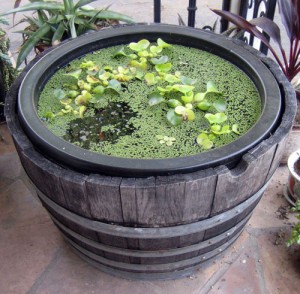





 Small water features can require almost as much attention as a large garden pond. The time taken to carry out tasks may be much less, but it is necessary to be just as vigilant in ensuring that all is well.
Small water features can require almost as much attention as a large garden pond. The time taken to carry out tasks may be much less, but it is necessary to be just as vigilant in ensuring that all is well.
The advice given for autumn and winter applies mainly to colder climates.
This is the best time to create a container water feature and to plant it and install moving water if you wish to.
Carry out new plantings in existing features and introduce fish where appropriate.
Reintroduce overwintered plants and, where appropriate, divide them. Lift and divide crowded clumps of plants that have remained in the open.
Fertilise established plants, using specially formulated aquatic plant fertiliser tablets or sachets pushed into the soil next to the plants.
Feed fish if the weather is warm and they are swimming around actively.
To prevent nutrients escaping into the water and creating a green algal bloom, use sachets of aquatic plant fertiliser. Tear off the protective strip to reveal the perforations and place in the compost next to each plant. Top dress with fine gravel.
There is still time to plant and establish a new water feature. Later plantings do not flower as freely as those made during the spring, but they are still worthwhile. Fish can be introduced at any time during the summer months.
Keep a close watch for green and discoloured water and use an algicide if necessary. You can treat blanket-weed and other filamentous algae chemically, but they must still be removed by hand to prevent them from decomposing and de-oxygenating the water.
As flowering plants fade, remove the old heads and flower stalks. It is not only tidier to do this, but the plants’ energy is conserved by preventing them from setting seed. Also remove dead leaves regularly.
Keep an eye open for any pests and diseases that may affect the plants. Troublesome aphids are easily disposed of with a strong jet of water or by using a systemic insecticide.
With the approach of autumn, tidy up all the plants and remove those that are going to be overwintered indoors from their containers. To overwinter most aquatic plants successfully, plant them close together in deep trays of damp compost in a frost-free place. In warmer climates, where the temperature does not drop below -5°C (23°F), many hardy aquatics are best left where they are to overwinter.
The turions, or overwintering buds, of floating plants such as Hydrocharis morsusranae (frogbit), and the spiky nuts of Trapa natans (water chestnut) usually overwinter on the floor of the pool. If you intend to empty the container for the winter, gather a few turions and place them in a bucket of water with a little soil on the bottom; they will keep successfully until spring. Such tactics are essential if the plants are to be preserved. Even when they would normally be allowed to remain where they are, it is advantageous to be able to start them indoors, particularly if the spring season is late getting under way.
Treat any lingering algae with an algicide and, where appropriate, empty the containers and bring them inside in preparation for the winter.
For the small container water garden, winter is not the best time. While it is feasible to retain one or two features, such as a sunken barrel or a lion mask, in good order outside, in general, containers are best drained, cleaned and placed in a frost-free place for the winter.
Storing Plants:
Place the plants closely together in deep trays of compost and put them in a frost-free place.
Overwintering Floating Plants:
Place winter buds in a bucket of water with a little soil on the bottom.
Copyright © www.100flowers.win Botanic Garden All Rights Reserved